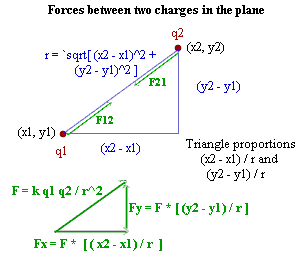
Problem: What are the x and y components of the electric force on a charge of 5 `microC at the point ( 13 m, 1 m), due to a charge of 10 `microC at ( 17 m, 3 m)?
.
.
.
.
.
.
.
.
.
.
.
.
.
.
.
.
.
.
.
.
.
.
.
.
.
.
.
.
.
.
Solution: The force on the charge is one of repulsion, so will be in the direction from ( 17, 3) to ( 13, 1). The distance between charges is `sqrt[( 13- 17)^2+( 1- 3)^2] m = 4.472 m. The magnitude of the force is (9 x 10^9 N m^2/C^2)( 5 x 10^-6 C)( 10 x 10^-6 C)/( 4.472 m)^2 = .022 N. The x and y displacements from charge 5 `microC to 10 `microC are, respectively, 4 m and -2 m, so the x and y components are in proportion 4/ 4.472, and -2/ 4.472 to the force. The x and y forces are therefore ( 4/ 4.472)( .022 N) = .020 N and ( -2/ 4.472)( .022 N) = -.010 N.
Generalized Response: If charges q1 and q2 are at respective positions (x1, y1) and (x2, y2) in the plane, then by the Pythagorean theorem the distance between the charges is r = `sqrt[ (x2 - x1)^2 + (y2 - y1)^2 ] and the magnitude of the force on either charge is | F | = k |q1 q2 | / r^2. The force F12 exerted on charge 1 by charge 2 is equal and opposite to the force F21 exerted on charge 2 by charge 1.
The fundamental triangle between the two points has legs of length (x2 - x1) and (y2 - y1); the proportions `dx / r and `dy / r are therefore
`dx/r = (x2 - x1) / r and
`dy / r = (y2 - y1) / r,
with r as computed above. The x and y components of the forces F12 are therefore
F12x = F12 `dx / r and
F12y = `F12 `dy / r.
The components of F21 are found similarly.
.
.
.
.
.
.
.
.
.
.
Figure description: The figure below depicts the charges q1 and q2 at points (x1,y1) and (x2,y2). The legs and hypotenuse of the fundamental triangle are indicated (the hypotenuse is found using the Pythagorean Theorem; the legs are found by the obvious means). The force vectors F12 and F21 are depicted, assuming an attractive force resulting from opposite charges. The second figure shows the force vector F12 broken into components; the triangle so formed is similar to the upper triangle, so the same proportions apply between sides of both triangles; in particular the proportions (x2 - x1) / r and (y2 - y1) / r are used to obtain the x and y components of F12 .